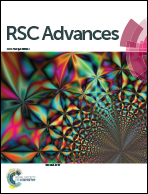Self-structure formation in polyadenylic acid by small molecules: new insights from the binding of planar dyes thionine and toluidine blue O†
Abstract
Self-structure induction in single stranded poly(A) is a promising approach that can switch off protein production and pave a new route for the development of RNA based therapeutic agents. Utilising spectroscopic techniques and isothermal titration calorimetric methods, we examined the ability of two DNA binding phenothiazinium dyes, thionine (TH) and toluidine blue O (TB), to induce structural changes in ss poly(A). The cooperative binding of both the dyes to ss poly(A) was revealed from absorbance and fluorescence studies. The binding affinity was of the order of 106 M−1 at 50 mM [Na+] as determined from spectroscopic and calorimetric studies. Ferrocyanide quenching and viscosity studies showed intercalative binding of the dyes to poly(A). The binding perturbed the circular dichroism spectrum of poly(A) with concomitant formation of prominent induced CD bands in the 300–700 nm region for the dyes. Poly(A) forms self-structure in the presence of both TH and TB. The binding affinity and the ease of formation of self-structure increased with [Na+] in the presence of the dyes in the range 50–200 mM. The single stranded poly(A) binding affinity of TH is higher compared to TB. Poly(A) may be a potential bio-target of these dyes in their pharmacological application.


 Please wait while we load your content...
Please wait while we load your content...